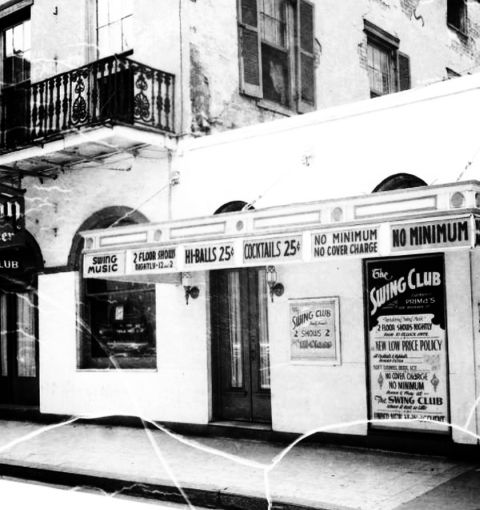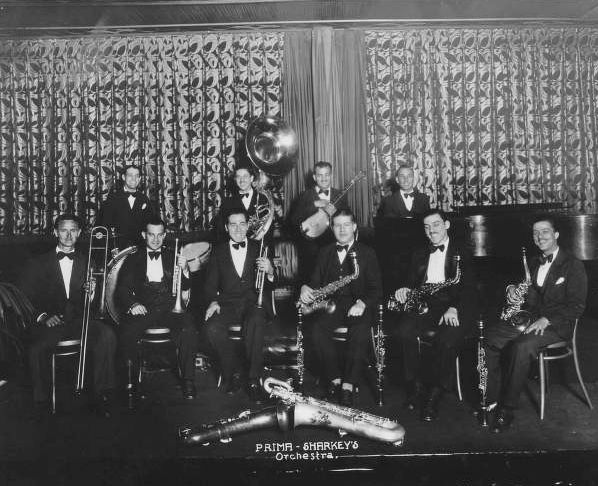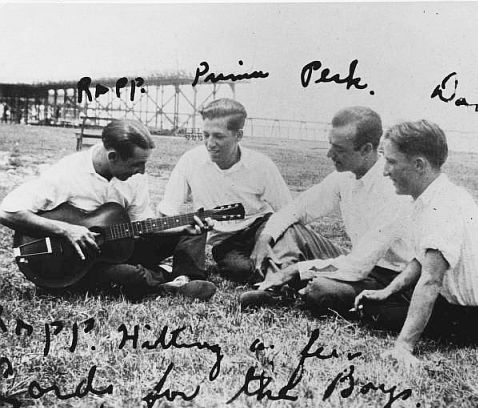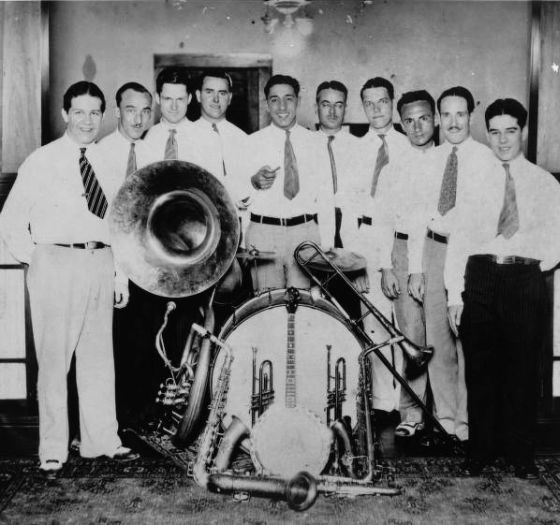|
Today in New Orleans History |
|
|
August 24


 To receive an update for each day in New Orleans history,
join our facebook page - Today in New
Orleans History.
Edmond "Doc" Souchon
Dies Photograph from the Louisiana Digital Library Born on October 25, 1897
to a prominent New Orleans family, Edmond Souchon II was a passionate lover of jazz and a dedicated physician. He practiced
medicine at Hotel Dieu (as chief of staff), Charity, De Paul, Mercy, and Crippled Childrens Hospitals. He was a founding
member of the Louisiana Surgical Association, a pioneer user of sodium pentathlon as a general anesthetic, and a life fellow
of the American and the International College of Surgeons. He was a director of Pan American Life Insurance Company and
the Krewe of Rex. “Doc” formed his first band, The Six and 7/8 Sting Band (which played
music akin to jazz before the term had been coined) while attending Tulane University. He played guitar and banjo with many
of jazz' best musicians including Johnny Wiggs, Sherwood Mangiapane, Papa Jack Laine, and Paul Barbarin. He
is credited with the historical preservation of jazz during his lifetime. To accomplish that he featured great local musicians
and their music on a WWL radio show, contributed to Life, Newsweek, and Time magazines, lectured and appeared on national
radio and television programs. He had become so well known for his avocation as a local jazz enthusiast that On May 5, 1961
he appeared on the popular “This is Your Life!” television show hosted by Ralph Edwards. Souchon
played benefits for Crippled Children's Hospital, established the National Jazz Foundation and the New Orleans Jazz Museum,
recorded some 500 songs, was a president of the New Orleans Jazz Club, and edited their publication, Second Line, from
1951 until his death. He could not read a note of music. In 1967, with Al Rose, he wrote New Orleans
Jazz: A Family Album. “Doc” Souchon died, playing his guitar for friends and family, on August 24, 1968 in his
home at 523 Betz Place. He bequeathed 5000 records and a library of literature to the New Orleans Public Library and the
William Ransom Hogan Jazz Archives at Tulane. He is pictured here (center) with Sharkey and Mildred Bonano at a party in their
home. From Legendary Locals of Metairie by Catherine Campanella.  To receive an update for each day in New Orleans
history, join our facebook page
- Today in New Orleans History
John Schwegmann was in hot water on August 24, 1973 for fighting a "milk war"
between his grocery stores and the "orderly milk marketing law" also known as a price-fixing law. Schwegmann promised
his customers rebates if the law was enacted. The First Circuit Court of Appeals ordered him to cease what it interpreted
as illegal acts. See August 14.
Born on October 25, 1897 to a prominent New Orleans family, Edmond Souchon II was a passionate lover
of jazz and a dedicated physician. He practiced medicine at Hotel Dieu (as chief of staff), Charity, De Paul, Mercy, and
Crippled Childrens Hospitals. He was a founding member of the Louisiana Surgical Association, a pioneer user of sodium pentathlon
as a general anesthetic, and a life fellow of the American and the International College of Surgeons. He was a director
of Pan American Life Insurance Company and the Krewe of Rex. “Doc Souchon” formed his first band, The Six and
7/8 Sting Band (which played music akin to jazz before the term had been coined) while attending Tulane University. He played
guitar and banjo with many of jazz' best musicians including Johnny Wiggs, Sherwood Mangiapane, Papa Jack Laine, and Paul
Barbarin. He is credited with the historical preservation of jazz during his lifetime. To accomplish that he featured great
local musicians and their music on a WWL radio show, contributed to Life, Newsweek, and Time magazines, lectured and appeared
on national radio and television programs. He had become so well known for his avocation as a local jazz enthusiast that
On May 5, 1961 he appeared on the popular “This is Your Life!” television show hosted by Ralph Edwards. Souchon
played benefits for Crippled Children's Hospital, established the National Jazz Foundation and the New Orleans Jazz Museum,
recorded some 500 songs, was a president of the New Orleans Jazz Club, and edited Second Line (page ???) from 1951 until his
death. He could not read a note of music. In 1967, with Al Rose, he wrote New Orleans Jazz: A Family Album. “Doc”
Souchon died, playing his guitar for friends and family, on August 24, 1968 in his home at 523 Betz Place.
He bequeathed 5000 records and a library of literature to the New Orleans Public Library and the William Ransom Hogan Jazz
Archives at Tulane. He is pictured here (center) with Sharkey and Mildred Bonano at a party in their home.
Jim Gaines announced the opening of the first Kentucky Fried Chicken outlet in Louisiana on August
24, 1963. From his location at 7328 Chef Menteur Highway he would offer the then standard menu at tables, for
delivery, or for take-out. Mr. Gains noted that if this first location in the city turned out to be a success he would
open more outlets in New Orleans. Dorothy Violet Gulledge, an amateur photographer, born in Perry County, Mississippi, on August 24, 1908, snapped 2,818 photographic color slides of Louisiana and Mississippi scenes from 1947 until 1973. Her family moved to New Orleans in 1922, where she lived for the rest of her life. Miss Gulledge worked as a stenographer and office manager for the Liquid Carbolic Corporation in the 1930s, and from the 1940s-1970s, as a legal secretary. According to Ann Garza, Miss Gulledge's sister and the donor of Dorothy's collection to the New Orleans Public Library, Miss Gulledge enjoyed travelling and took photographs on her travels. Many of the photographs were apparently taken during commercial bus tours to plantation homes and other sites or during organized tours of French Quarter courtyards, possibly in connection with New Orleans' annual Spring Fiesta. She also enjoyed taking long walks in the French Quarter and elsewhere to take photographs. She did not drive but traveled around the city by streetcar and bus with her camera. Miss Gulledge died on November 1, 1988. Click here to view her collection of photographs. BARRETT, John Bruce, master machinist. Born, New Orleans, August 13, 1896; son of John Augustus Barrett (q.v.) and Imogene Isabella Cassidy. Education: New Orleans public schools. Employed by New Orleans Sewerage and Water Board, Algiers Iron Works, Algiers Dry Docks and Federal Barge Line. Member, Catholic church; Knights of Columbus, Crescent Chapter No. 3; held all the chairs in the Saints John Masonic Lodge No. 153 F. & A.M., Worshipful Master, 1947; Eastern Star St. John Chapter No. 35; St. John Chapter No. 98 R.A.M.; Democratic party. Married, December, 1921, Carmen Elizabeth Vanderlinden of New Orleans, daughter of Joseph Jules Vanderlinden and Anna Eliza Cayard. Children: Carmen Marguerite (b. 1923), Ralph Bruce (b. 1926). Died, August 24, 1958, New Orleans; interred Metairie Cemetery. C.M.B. Sources: J. B. Barrett family records; birth certificate, marriage certificate (Book No. 46, folio 9W), and death certificate (58 05971), New Orleans Vital Records; Trinity Lutheran Church, New Orleans, La.; Saints John Chapter Masonic Lodge, No. 153, F. & A.M.; obituary, New Orleans Times-Picayune and New Orleans States; Louisiana Census, 1900, 1910. From http://lahistory.org/site19.php
August 24th, 1780: A hurricane worse
that the August 1779 storm swept over the province of Louisiana striking New Orleans; destroying crops, tearing down
buildings and sinking every vessel and boat afloat on the Mississippi River and on area lakes. It was during this storm
that Dunbar noted that tornadoes form around tropical storms and seldom lasted more than 5 to 10 minutes. This was of
no comfort to the inhabitants of the area, who were distraught after these two storms and an excessively cold winter followed
by a very rainy summer. These residents wrote the Spanish sovereign not to abandon the country regardless of the adverse
blows of nature. The following is a description of the hurricane from page 235 of the book History of Louisiana History of Louisiana, The (Louisiana Parish Histories Series) by Francois Xavier Martin. "...On the twenty-fourth of August, Louisiana was desolated by a hurricane. This year the
Mississippi rose to a greater height than was remembered by by the oldest inhabitants. In the Attakapas and Opelousas, the
inundation was extreme. The few spots which the water did not reach were covered with deer..." (NOAA) Life Goes on Without Louis Prima |
|
|

To receive an update for each day in New Orleans history,
join our facebook page - Today in New
Orleans History.
Analytics |
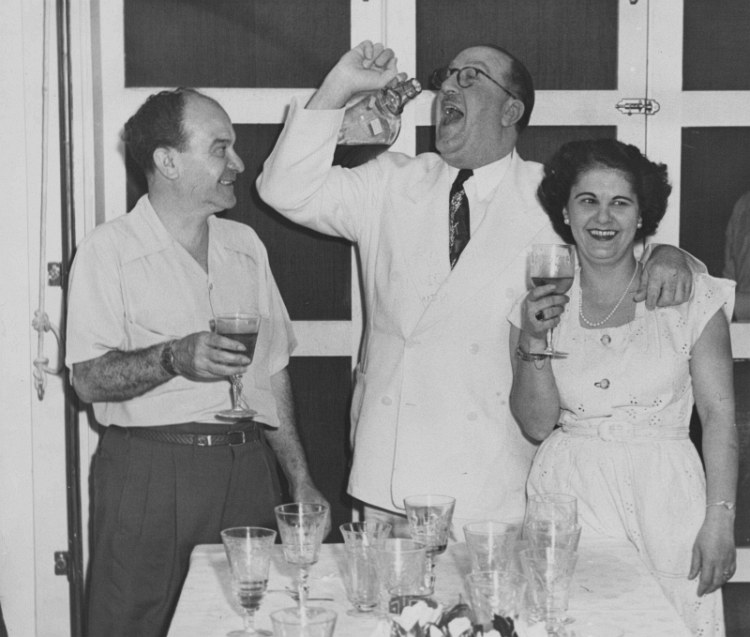
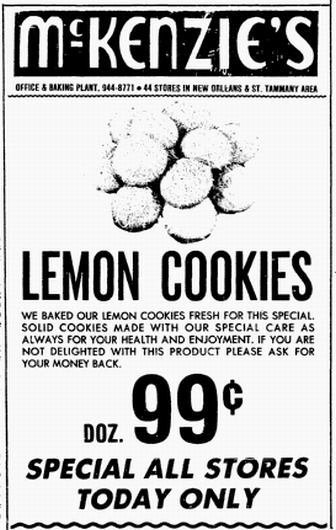 Augst 24, 1983 McKenzie's Lemon Cookies advertisement.
Augst 24, 1983 McKenzie's Lemon Cookies advertisement.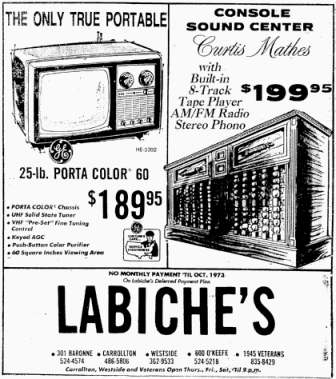 August 23, 1983 advertisement for Labiche's several locations -- Barrone, Carrollton, Westside, O'Keefe,
Veterans Highway.
August 23, 1983 advertisement for Labiche's several locations -- Barrone, Carrollton, Westside, O'Keefe,
Veterans Highway.